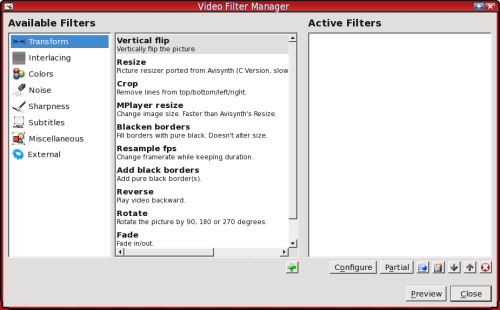

- Avisynth add borders mp4#
- Avisynth add borders full#
- Avisynth add borders software#
- Avisynth add borders trial#
So if you have a 17" (43.18 cm) monitor and want to see the same picture size as the owner of a 55 cm TV set watched from a distance of 3 meters, the distance between you and your monitor should be :ĭ = 3 x (0.96 x 43.18) / 55 = 2.26 meters. Picture diagonal is reduced by a 0.96 factor, due to the black borders. One additional refinement would be to watch from a distance that will allow for the same apparent picture size as the one experienced by the viewers at the time of the real broadcasts. It is also better to use the repeat mode, since it is such a small clip. In MPUI, you can go to preferences and add -cache 50000 in the parameters box. In VLC, you have to open the file in advanced mode, show all options to see the cache setting, and use 1000 ms. It is better to use some cache to smooth the video playback, as these are high datarates.
Avisynth add borders trial#
I had to resort to a trial version of Powerstrip to get the setting i needed.
Avisynth add borders full#
open the video in your player and display it full screen (mandatory)īe sure to deactivate deinterlacing, too, as it produces flashing video in MPC-HC, for example.Īs for me, i had trouble with my stupid ATI driver, which allows me to use 50 Hz, or 1024x768, but not both at the same time. (careful, it weights 500 MB, and that is only for a 20s duration) download the short video i have put at: Or even Windows Media Player (not sure if it uses ffdshow or not) Media Player Classic- Home Cinema + ffdshow + reclock
Avisynth add borders software#
Some software player compliant with these codecs and datarates.
Avisynth add borders mp4#
Ideally the monitor should be set to 50 Hz refresh rate, but surprisingly it does not create awful artifacts if you use some other rate.Ī PC with a CPU and hard disk able to cope with lossless (HuffYuv) encoded "819p/50", monaural AAC sound, all in an mp4 container. It would normally be a CRT monitor operated at XGA setting, or perhaps an LCD with a native 1024x768 matrix (but i have not tried that and it is further from the historical truth anyway). In principle, of course, these could also be simulated.Ī 4/3 monitor able to operate at exactly 1024x768 resolution. This represents the highest possible quality with this standard, not taking into account the impairments produced by modulation/demodulation, propagation conditions, and the limitations of 819 lines cameras, or of the mass-produced 819 lines TV sets. I will also try to upload a 1080p/50 based video soon. Video, produced from 1080p/25 material (well, sped-up 24p, in fact), in black & white,Īlmost full screen (20 pixels wide black borders at most), together with monaural Interlace emulation on a progressive PC monitor, with full 819 theroretical definition you don't look forward to putting your fingers in 15 kv circuitry or witnessing a you have grave doubts regarding your ability to put it back in working order, you consider your chances to lay your hands on a workable 819 TV set to be slim at best, your are disapointed by the fact that Aurora converters just show blown up 625, If, just like me, you are curious to see 819 lines (again), but:

( long post but practical details are mostly at the beginning)


 0 kommentar(er)
0 kommentar(er)
